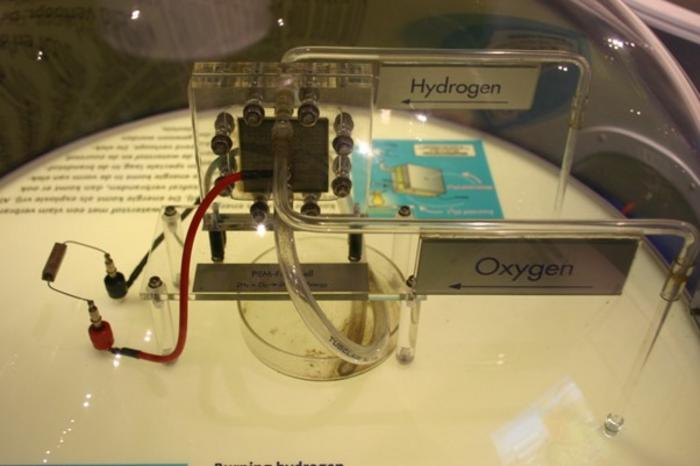Fossil fuels are major contributors to pollution, leading to global warming and erratic climatic fluctuations. Hydrogen fuel cells are a promising eco-friendly alternative to fossil fuels, since they use hydrogen as a source to produce electricity, releasing only water and heat in the process.

Credit: Ryan Somma from FLICKR
Image link: https://search-production.openverse.engineering/image/edb01022-4dea-4ad9-98a9-886fa77fe9a3
Fossil fuels are major contributors to pollution, leading to global warming and erratic climatic fluctuations. Hydrogen fuel cells are a promising eco-friendly alternative to fossil fuels, since they use hydrogen as a source to produce electricity, releasing only water and heat in the process.
Several types of hydrogen fuel cells exist, among which anion exchange membrane alkaline fuel cells (AEMFCs) are quite popular. These employ anion exchange membranes (AEMs), which require excellent chemical stability to perform efficiently under alkaline conditions. Poly(aryl piperidinium) (PAP) is a potential candidate for the preparation of these membranes. However, early prototypes created purely from this polymer have sub-par mechanical strength and phase separation, necessitating further modifications.
To this end, Professor Tae-Hyun Kim and colleagues at the Incheon National University, South Korea, have developed a new AEM by crosslinking poly(bibenzyl N-methyl piperidine) (PBB)—a rigid PAP unit—with poly(styrene-b-ethylene-co-butylene-b-styrene) (SEBS)—an elastic component. They also evaluated the new AEM’s (x-PBB-SEBS) physical, chemical, and electrical properties under laboratory and real time fuel cell conditions.
Discussing the motivation behind the study, which was published online on October 13, 2022 in volume 664 of Journal of Membrane Science, Prof. Kim remarks, “This research was conducted primarily to improve the performance and durability of anion exchange membrane alkaline fuel cells through the development of electrolyte membranes, the key components of fuel cells.”
The research team developed three types of membranes with varying degrees of crosslinking (30%, 40%, and 50%) by modifying the ratio of PBB to SEBS. All three exhibited high mechanical and tensile strength, excellent phase separation, and ionic conductivity.
Furthermore, the membrane with the 40% crosslinking (40x-PBB-SEBS) proved to be the most optimal with respect to its balance between toughness and elasticity.
It also demonstrated a very high ionic conductivity of 72.28–146.25 mS cm–1, and outstanding alkaline and oxidative stability, due to its increased crosslinking.
Moreover, as AEMs function as electrolytes, they require high water retention for a satisfactory performance. On testing the membranes in an AEM fuel cell, the team found that 40x-PBB-SEBS recorded the highest relative humidity, normalized conductivity, and an impressive peak power density. The membrane even surpassed the performance of a commercially used membrane by a huge margin, when tested in real time using AEM water electrolysis!
These findings have laid a strong foundation for the development of additional high-performance materials for AEMs with superior performances. Sharing his vision for the future, Prof. Kim muses, “The capabilities of the bibenzyl-SEBS crosslinked membrane exhibits can enable their introduction into hydrogen mobility and home power generation systems as well as in eco-friendly hydrogen production facilities. In this manner, our research can contribute to eco-friendly energy production and carbon neutrality.”
***
Reference
DOI: https://doi.org/10.1016/j.memsci.2022.121071
Authors: Kyungwhan Mina, b, Yerim Leea, b, Yeongeun Choic, Oh Joong Kwonc, Tae-Hyun Kima,b
Affiliations:
aOrganic Material Synthesis Laboratory, Department of Chemisty, Incheon National University, 119 Academy-ro, Yeonsu-gu, Incheon, 22012, South Korea
bResearch Institute of Basic Sciences, Incheon National University, 119 Academy-ro, Yeonsu-gu, Incheon, 22012, South Korea
cDepartment of Energy and Chemical Engineering and Innovation Centre for Chemical Engineering, Incheon National University, Incheon, Republic of Korea
About Incheon National University
Incheon National University (INU) is a comprehensive, student-focused university. It was founded in 1979 and given university status in 1988. One of the largest universities in South Korea, it houses nearly 14,000 students and 500 faculty members. In 2010, INU merged with Incheon City College to expand capacity and open more curricula. With its commitment to academic excellence and an unrelenting devotion to innovative research, INU offers its students real-world internship experiences. INU not only focuses on studying and learning but also strives to provide a supportive environment for students to follow their passion, grow, and, as their slogan says, be INspired.
Website: http://www.inu.ac.kr/mbshome/mbs/inuengl/index.html
About Professor Tae-Hyun Kim from Incheon National University
Dr. Tae-Hyun Kim is a Chemistry Professor at Incheon National University (INU), South Korea. He is also the director of the Research Institute of Basic Sciences at INU. Dr. Kim received a Ph.D. in Chemistry from Cambridge University, United Kingdom, and conducted his post-doctoral research at Massachusetts Institute of Technology, USA. Before joining INU, he was a senior research associate at Eastman Chemical Co. His research interests are primarily focused on the development of organic materials for multiple applications, including fuel cells, lithium batteries, water electrolysis, and gas separation. He has authored over 150 SCI journal articles and owns over 80 patents.
Journal
Journal of Membrane Science
DOI
10.1016/j.memsci.2022.121071
Method of Research
Experimental study
Subject of Research
Not applicable
Article Title
High-performance anion exchange membranes achieved by crosslinking two aryl ether-free polymers: poly(bibenzyl N-methyl piperidine) and SEBS
Article Publication Date
15-Dec-2022
COI Statement
The authors declare that they have no known competing financial interests or personal relationships that could have appeared to influence the work reported in this paper




